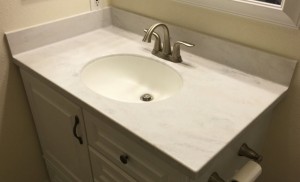
Whether you’ve already purchased your new vanity top, or you are in the research phase of buying one, the top is going to need to be installed One option, for the do-it-for-me type, would be to contact a professional or plumber to complete the install for you, but for the remainder of you we’ve written this handy instructional guide with some simple steps to install your new top.
The top photographed throughout this guide is a Custom Corian Vanity Top configured on SolidSurface.com, shipped directly to, and installed by, the homeowner.
Uncrating the New Vanity Top
Vanity tops ordered from SolidSurface.com come shipped in well-padded crates to help ensure safe arrival. Crate tops are secured with standard phillips head screws that can be unscrewed for easy access. The photos below show examples of an actual shipment.
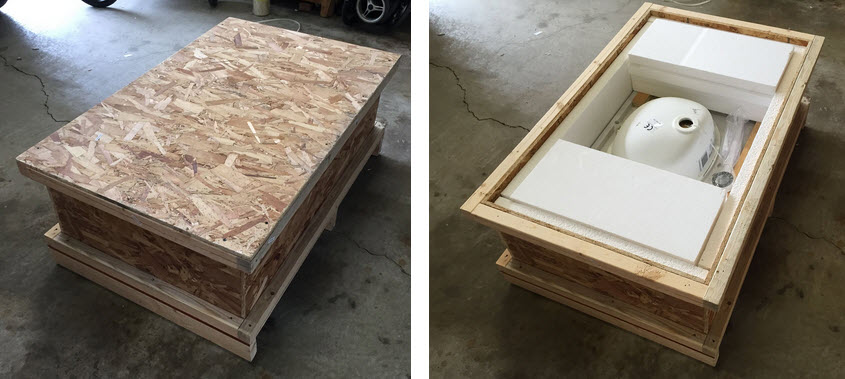
Consider repurposing the empty crate, as one creative customer did, with the crate turned flower box. The web is filled with great ideas of turning crate and pallet material into furniture, and we support recycling!
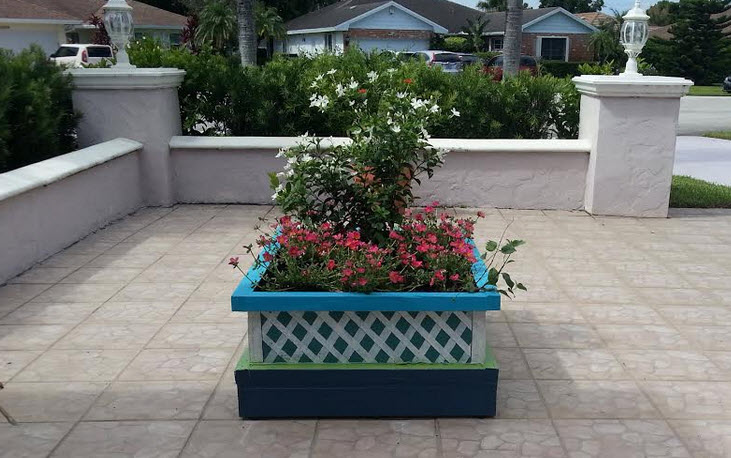
Fitting the Vanity Top to the Cabinet and Wall(s)
In most cases, the bathroom walls will be straight and square, and the floor level. But since this is not always the case, follow these tips to ensure the best snug and level fit against the wall.
Level the cabinet (use a shim if necessary) and position the new vanity top on the leveled cabinet. Be sure to check that the top rests on all corners of the cabinet. The top will arrive with strips of wood attached underneath so that there is a surface to rest on the edges of the cabinet, which will be further described later.
Next, check the fit to the back and any adjoining side wall(s). If it does not fit exactly, recall that the backsplash is ½” thick and will cover some wall irregularities when in place. If you are using tile as the backsplash, and it is not yet in place, the tile may be thick enough to cover any irregularities.
If the irregularities will not be covered by the backsplash or the tile, you may want to do one of two things: scribe (draw) a line onto the vanity top which will provide a reference mark for removing vanity top material or chisel a channel in the sheet rock wall area that is protruding.
Pro Tip: To scribe the line using a protractor, place the vanity top on the cabinet next to the wall(s) and run the metal pointed end of the protractor along the wall with the penciled end drawing a line on the vanity top. To determine how “open” (the distance from the metal tip to the pencil tip) the protractor should be, look for the largest gap between the wall and the edge of the vanity top and that distance is how much material should be removed. You can then cut or sand away any extra material on the wall facing side of the scribed line so the top will fit snugly against the irregular wall(s). If you cut away material from the vanity top be sure to sand the edge surfaces to be as smooth as the factory edges.
Pro Tip: To chisel a channel in the sheetrock, cut a line along the top of the vanity top into the sheetrock. Then do the same ½ “ lower by using the top of the cabinet as a guide. Next, chisel or dig out the material between the two razor cuts.
Install the Faucet Hardware
The vanity top will often arrive with the faucet hole(s) drilled. If not or if you want to add another hole, use a hole-saw, a twist drill or flat spade bit at medium speed. Then sand, using 120 grit sandpaper, the inside, top and bottom edges of the hole. The location template for the holes will likely accompany the faucet.
You are now ready to install the faucet hardware, hot and cold water supply lines, drain, and sink drain stopper. These fixtures are more easily installed before the top is attached to the cabinet. Follow the instructions that came with the faucet and drain. Be careful not to snag any of these dangling parts as you move the top into position on the cabinet.
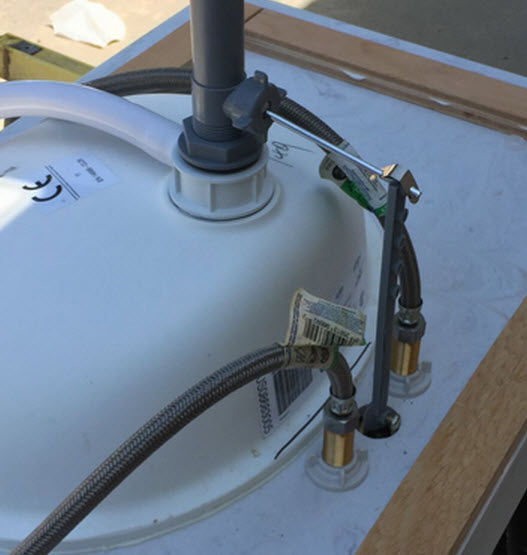
Attach the Top to the Cabinet
SolidSurface.com vanity tops typically arrive with strips of wood glued in place under the top. These strips elevate the top above the cabinet so the overhanging dropped edge won’t be in the way when you open drawers near the top of the cabinet.
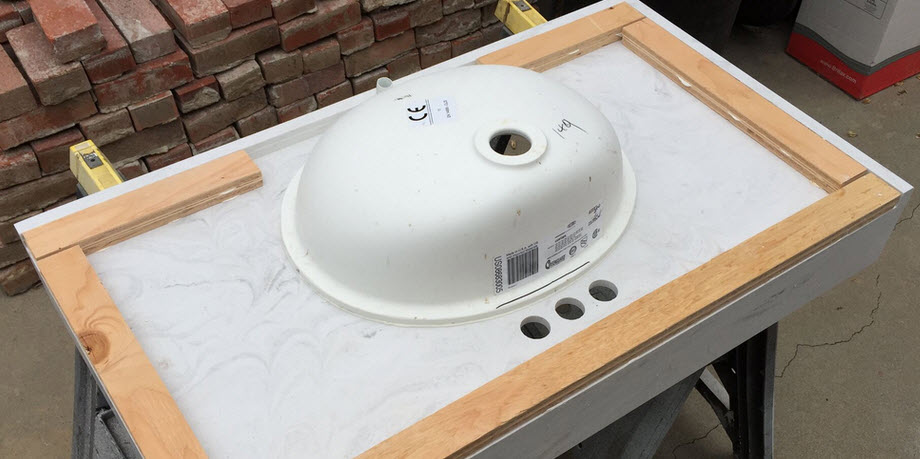
Before attaching the top to the cabinet, it’s crucial to first put the top in place and make sure everything fits as expected. Once this is complete, prop up one end of the top and apply daubs of silicone about every 12-18”. Do this to the other end and then let dry overnight.
Never use screws because the top has to be able to expand and contract a small amount, which is made possible by the use of silicone. Do not use full sheets of wood for support instead of wooden strips. The solid surface top needs to be able to dissipate heat (or cold) from the underside which will minimize uneven expansion and contraction.
If you are replacing a laminate or tile vanity top, you can leave the existing top in place, as long as large sections are cut away to allow for heat or cold dissipation. In practice, it is probably easier to remove the old top than to cut openings in an existing top.
Back and Side Splash Placement
Pre-cut back and side splashes are supplied to fit the width and depth of the vanity top. (If your vanity top has a coved back or side splash as seen below, skip to the last sentence of this section).
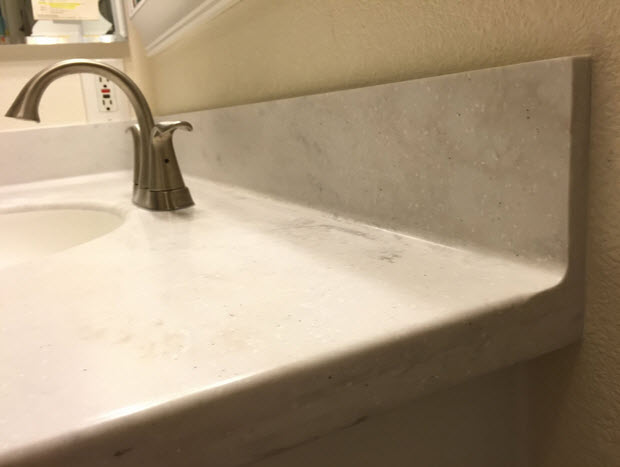
Orient the splash(s) so that the rounded edge is at the top and facing away from the wall. After cleaning the surfaces to be joined with denatured alcohol, install the backsplash first. Apply thumb size daubs to the back side every 12–18”. Position the splash slightly above the back edge of the vanity top using 1/32” thick spacers and push the splash onto the wall.
Repeat the process with the side splash(s).
With the back and side splashes in place, carefully apply a small bead of color matched silicone to the gaps between the vanity top and the bottom of the splashes and then press the splashes down onto the vanity top. To get a small bead of silicone, cut away only the very end of the tip of the silicone tube.
Pro Tip:To easily remove the excess silicone, spray the silicone and surrounding surface with Sprayway brand glass cleaner (other glass cleaner brands may work) and scrape away the excess with the straight edge of a shim or plastic squeegee. Spray again with more cleaner and wipe with a clean cloth. Repeat again if needed. The cleaner will keep the silicone from sticking to the surrounding areas but will not seep under the silicone and degrade the bond in the joint area itself.
At the top of the splash where it meets the wall, apply caulk of your choosing or colored silicone.
Attach to Plumbing
Fasten the hot and cold water supply lines to the shut off valves (angle stops) protruding from the wall. Next, fit the sink drain assembly to the plumbing and tighten the nut that secures them together. Turn the faucet(s) to the off position. Be sure to turn the water on and check for leaks. Next, run enough water into the sink to fill the p-trap and check the drain assembly for leaks.
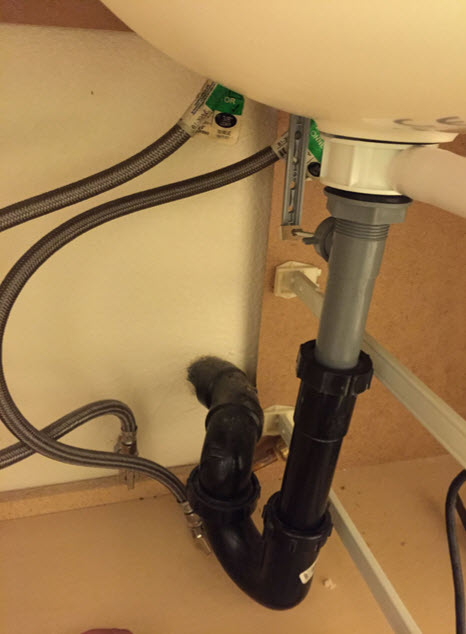
And, of course, the final and most important step of them all, enjoy your new vanity top for years to come.
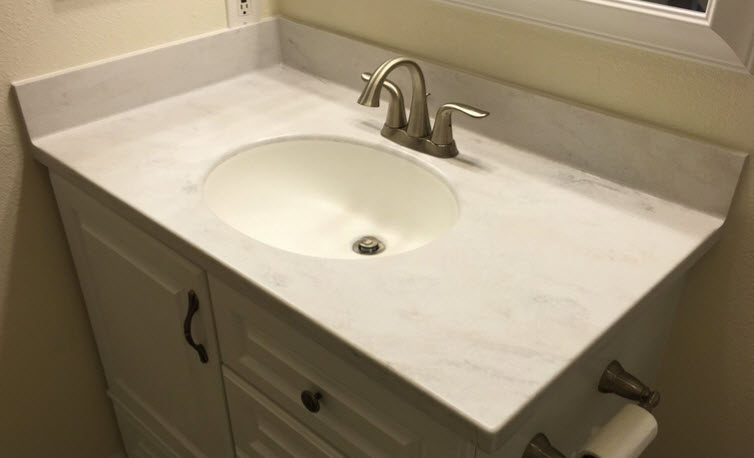





One Response
I have a Corian with overflow. Is there a special drainpipe I need to use? The ones that come with my facet end up with the stopper not reaching the pivot hold where I can pop up the stopper. The stopper ends up being too short.